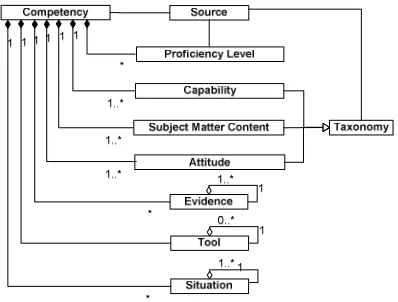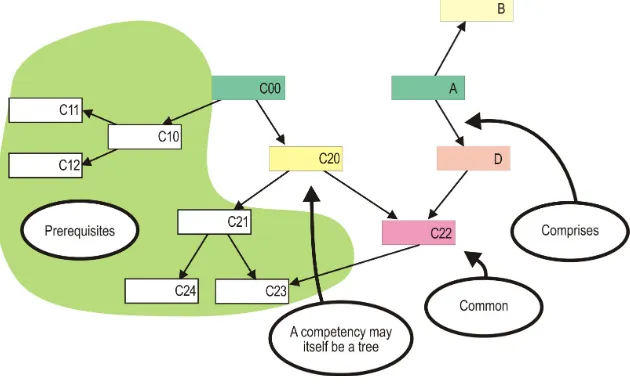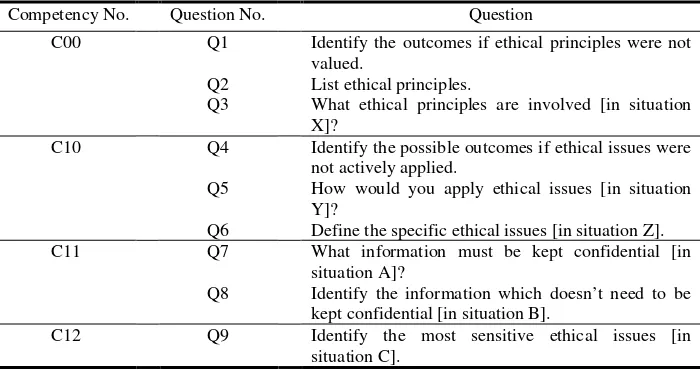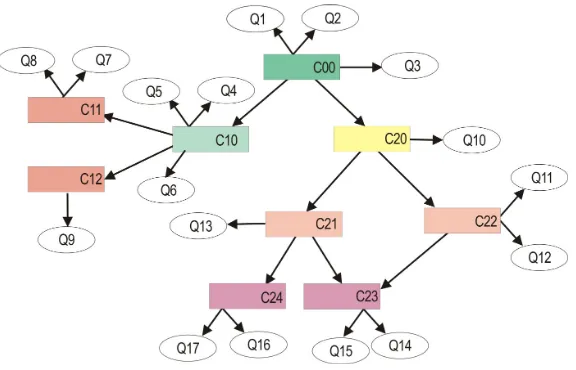Onjira Sitthisak, Lester Gilbert, and Hugh C Davis
Learning Societies Lab, School of Electronics and Computer Science, University of Southampton, Highfield, Southampton, SO17 1BJ, United Kingdom
{os05r, lg3, hcd}@soton.ac.uk
Abstract. The problem of comparing and matching different learners’ knowledge arises when assessment systems use a one-dimensional numerical value to represent “knowledge level”. Such assessment systems may measure inconsistently because they estimate this level differently and inadequately. The multi-dimensional competency model called COMpetence-Based learner knowledge for personalized Assessment (COMBA) is being developed to represent a learner’s knowledge in a multi-dimensional vector space. The heart of this model is to treat knowledge, not as possession, but as a contextualized space of capability either actual or potential. The paper discusses the automatic generation of an assessment from the COMBA competency model as a “guide-on-the–side”.
Keywords: competency, adaptive assessment, knowledge level
1
Introduction
In recent years, a variety of tools and learning environments have been created and installed in schools, universities, and organisations to support learning. Mostly these tools have been created to support e-learning content and collaborative learning activities like a virtual classroom [1]. However, e-learning suggests not only new technologies for instruction but also new pedagogical approaches to enhance learning. One new pedagogical approach is machine-processable competency modelling. A competence model is introduced for storing, organizing and sharing learners’ performance data in order to seek and interpret evidence for where the learners are in their learning, where they want to go, and how they can get there. Pedagogically effective and informed competency data is vital in any assessment system.
consider the learners’ “learned capability” instead of their “knowledge level”, and to consider competencies and learned capabilities as a multidimensional space.
In the context of an adaptive assessment system, an assessment is part of the process of diagnosing the learner’s competence. The key idea of an adaptive assessment system is that questions are selected by the computer to individually match the learner’s competence [4]. The system’s evaluation of the learner’s competence is then used to guide the adaptation of the system [5]. The system may skip over what learners have learned and find out what they should learn further. While an adaptive system may be more efficient for summative assessment, a system of adaptive formative assessment is likely to be of greater advantage to learners, since they would receive relevant, personalized feedback. Establishing adaptive formative assessment systems to support lifelong learning is extremely challenging and relies on introducing a competency model to the adaptive assessment. Our intention is not to promote a particular technological platform, but to demonstrate how a competency model can be applied to adaptive assessment.
In this paper, we introduce an advanced competency model named COMpetence-Based learner knowledge for personalized Assessment (COMBA). The COMBA model is represented in a multi-dimensional vector space, and we explore the assembly of competencies into a tree structure. We then consider the key task of adaptively generating assessments from such a competencies structure.
2
The Multi-dimensional COMBA model
Competence-based approaches in the field of e-learning, institutional admissions, learners seeking courses, e-portfolios, job references, human resource management, and job descriptions are becoming more common. They appear to offer the opportunity to develop tools and services for data exchange, discovery, processing, analysis, and visualization to meet needs of learners, tutors, program managers, examination bodies, professional societies, employers, legislators, and so on. We suggest that a complete and coherent model of competencies would support storing, organizing and sharing of achieved, current, and intended performance data relating to all aspects of education and training in a persistent and standard way [3]. We have been developing a competency model, named COMBA, which is proposed for all domains where learning and teaching take place.
learner exhibits their knowledge and skill, is included in the COMBA model, as illustrated in Fig. 1.
[image:3.595.202.401.218.369.2]The COMBA model considers knowledge in the widest possible sense, and involves the following four major components: subject matter, capability, attitude, and context, along with metadata as illustrated in Fig. 2.
Fig. 1. Competency model including attitude component
Fig. 2. Individual competence model
[image:3.595.171.429.422.598.2]and their simplistic assumptions that knowledge is some thing a learner possesses or fails to possess.
The heart of the COMBA model is to treat knowledge, not as possession, but as a contextualized multidimensional space of capability either actual or potential. Accordingly, the three important components of the COMBA model (capability, subject matter content, and attitude), which are referred from relevant taxonomies or ontologies, may be represented in a vector space as in Fig. 3. The learned capability is the learner’s required or observed behaviour, for example using Bloom’s taxonomy [10]. The subject matter content in Fig.3 is based on Merrill’s analysis [11], and attitude is based on a version of Krathwohl’s taxonomy [12].
Fig. 3. Multidimensional space of competency model
In this paper, we choose competencies from health care because they are amongst the most sophisticated and challenging to implement [13]. Table 1 represents some nursing competencies based on the multidimensional space of the COMBA model. For example, C00 (students are able to use and value ethical principles) comprises C10 (students are able to actively apply ethical principles) and C20 (students are able to actively use professional regulation). In order to achieve C10, students should be able to demonstrate client confidentiality respectfully (C11), and to identify ethical issues sensitively (C12). In order to achieve C20, students should be able to identify the limitations in their own practice (C22), and to considerately evaluate professional regulation (C21). There is a common competency for C21 and C22 which is C23 (students are able to recognize the need for referral willingly). In order to achieve
Attitude Subject Matter
C21, students should be able to recall relevant professional regulations willingly (C24). This shows that we can map effectively these more complicated competencies into the COMBA model.
Table 1.Some example nursing competencies represented in the competency model
Competency No. Capability Subject Matter Content Attitude
C00 Use Ethical principles Values
C10 Apply Ethical issues Actively
C11 Demonstrate Client confidentiality Respectfully
C12 Identify Ethical Issues Sensitively
C20 Use Professional regulation Actively
C21 Evaluate Professional regulation Considerately C22 Identify Limitation in own practice Values
C23 Recognize Need for referral Willingly
C24 Recall Professional regulations Willingly
3
The Competency tree
Competencies are assembled into trees. A tree structure is a particular way of representing a structure in a graphical form [14]. While the relationship between nodes is modelled as a family relation such as parent and child, there is no ordering of nodes on the same level, and this yields a tree structure rather than a hierarchy. It is assumed that all children of a defined competency are required in order to achieve proficiency for the parent. While the tree structure defines a top-down or bottom-up structure, it does not imply sequencing as might be implied in a hierarchy. For example, a competency tree may specify how to roll up the assessment for each competency throughout a competency tree without implying sequencing of assessments of same level competencies. So the issue of pedagogical sequencings are not considered at this stage by representing competencies as a tree structure instead of a hierarchy.
One of the advantages of a competence tree structure is that a tree structure separates the composition rule in the domain from other structural components. Hence, an application of the competency model, such as in adaptive assessment, may add other rules, perhaps based on pedagogical sequencing, in order to control the adaptation within the competency tree.
More technically, the COMBA model specifies the network of assembled competencies as a directed acyclic graph. In competency terms, Fig. 4 implies that competency C00 is decomposed into sub-competencies C10 and C20, such that C10
and C20 contribute to C00. A node may have more than one parent, provided the
parent is not a child of the node. Fig. 4 shows a “forest” of two competency trees, where arrows represent parent-child relationships. A competency tree may specify common children for more than one node, or more than one origin node. For example,
C00 and A represent different competencies that have certain competencies in
It is expected that competency trees will be different for different communities and users. For example, a tree of nursing competencies from the UK Royal College of Nursing would have many points of difference from a similar tree from the Canadian Nursing Association. At a personal level, a student nurse may develop his or her own tree to reflect their own competencies, both achieved and to be attained.
Fig. 4.Competency tree
4
Generating assessment items from a competency tree
Assessments may be categorized as formative, summative, or diagnostic [15]. Formative assessment provides prescriptive feedback to assist learners in achieving their competences [16]. It is intended to help the learner deal with deficiencies in their understanding, knowledge, or competence. In contrast, summative assessment is generally given at the end of a period of learning to establish what knowledge, skills, and/or attitudes the learner has acquired over a period of time. It helps to establish whether learners have attained the competences required, and is not focussed on supporting learning. Diagnostic assessment is an in-depth assessment related to strengths and weaknesses in each skill area, which identifies priorities and needs [17]. It helps to determine what learners can already do within the goals of the curriculum. This paper focuses on formative and diagnostic assessment.
4.1 Constructing an assessment item
We assume an assessment which takes place in the context of the COMBA model. The competency tree might be used to drill down into component competencies for the tested competency, helping to define what to test and how to test it. An assessment for a competency often actually tests component competencies. For example, a paediatric nurse course [19] may test knowledge of professional regulation by testing the learners’ ability to demonstrate and evaluate understanding of professional regulation including the demonstration of a variety of specific skills and attitudes, as illustrated in Table 1.
[image:7.595.121.471.365.550.2]A generic assessment item can be directly formulated from a competence specification by using the parameters of that competence: capability, subject matter content, attitude and other contexts such as tool and situation. For example, the assessment corresponding to C11 might be something like “What information must be kept confidential in situation A?”, or “Identify the information which doesn’t need to be kept confidential in situation B”, as illustrated in Table 2.
Table 2. Some example questions represented from the competencies
Competency No. Question No. Question
C00 Q1 Identify the outcomes if ethical principles were not valued.
Q2 List ethical principles.
Q3 What ethical principles are involved [in situation X]?
C10 Q4 Identify the possible outcomes if ethical issues were not actively applied.
Q5 How would you apply ethical issues [in situation Y]?
Q6 Define the specific ethical issues [in situation Z]. C11 Q7 What information must be kept confidential [in
situation A]?
Q8 Identify the information which doesn’t need to be kept confidential [in situation B].
C12 Q9 Identify the most sensitive ethical issues [in situation C].
A formative assessment may contain items to test finer grained competencies. A competency tree can be used as a guide to assemble the necessary set of test items for assessing each competency. In this process, the competency tree is transformed to an assessment tree. An assessment tree consists of question nodes from Table 2, where each question node corresponds to a competency node, as illustrated in Fig. 5.
Fig. 5The group of questions based on a competency tree
4.2 Navigating assessment items on the competency tree
There are a number of adaptive assessment methods and technologies that can be used to assess learners’ strengths and weaknesses based on item-by-item and learner responses [20]. These allow learners to be tested on materials at a level appropriate to their current understanding. Adaptive assessments change their behaviour and structure depending on the learners’ responses and inferred abilities.
There are two major adaptation techniques; presentational adaptation and navigational adaptation [20]. An adaptive system may apply these two techniques with questions. Traversing the competency tree may start at the leaf node or the root node depend on the objective of each application. As a result, a competency tree may be traversed, mapped, extended, visualized, and searched by a variety of applications and tools. For example, a competency tree may be used to specify how to roll up the assessments for each competency in order to personalize the assessment and match assessment items to the individual competences of each learner.
[image:8.595.162.450.145.330.2]unfolding competences. The result of an adaptive assessment partitions the competency tree into “what the student can do” and “what the student is ready to learn” [21] and finding the boundaries of competence for the learner.
5
Conclusion
We have proposed the next generation of a competency model named COMBA to support adaptive assessment. The COMBA model includes “attitude”, identified as a critical issue exposed by working with nursing competencies, as well as including subject matter domain knowledge, and learned capabilities. The multi-dimensional COMBA model represents competency in terms of a tree structure. Generating assessment items from the competency tree is illustrated. Then, an adaptive assessment involves constructing an item sequence which dynamically reconfigures as the learner’s competency develops.
The benefits of a COMBA-enabled adaptive system are to help learners identify and diagnose their boundaries of their own competencies, understand them, and find out how to progress by comparing them with a given or ideal competency tree. Adaptive assessment involves the dynamic sequencing of assessment items derived from the COMBA competency tree depending on the learner's responses.
Learning is improved by allowing the learner to become familiar with the variety of assessment items that correspond to the variety of situations, tools, capabilities and subject matter content, expressed in a COMBA competence tree, of the domain of interest. We believe that a COMBA competency model is critical to successfully ensuring a pedagogic focus on learner and learning activities.
References
1. Koper, R. and M. Specht: TenCompetence: Lifelong Competence Development and Learning. in:Competencies in Organizational E-Learning: Concepts and Tools, M.-A. Sicilia, Editor. (2007), Idea Group.
2. Shepard, L.A.: The Role of Assessment in a Learning Culture. Journal Information for Educational Researcher. Vol. 29, No. 7. (2000), 4-14.
3. Sitthisak, O., L. Gilbert, and H.C. Davis: Towards a competency model for adaptive assessment to support lifelong learning. in TENCompetence Workshop on Service Oriented Approaches and Lifelong Competence Development Infrastructures. (2007). Manchester, UK.
4. Way, W.D.: Practical Questions in Introducing Computerized Adaptive Testing for K-12 Assessments, (2005)
5. Aroyo, L., P. Dolog, G.-J. Houben, M. Kravcik, A.N.a.M. Nilsson, and F. Wild: Interoperability in Personalized Adaptive Learning. Education Technology and Society. Vol. 9, No. 2. (2006), 8-14.
7. UK Royal College of Nursing, Available from http://www2.rcn.org.uk/cyp/resources/a-z_of_resources/competencies
8. Ramritu, P.L. and A. Barnard: New nurse graduates' understanding of competence. International nursing review. Vol. No. (2001).
9. Defloor, T., A.V. Hecke, S. Verhaeghe, M. Gobert, E. Darras, and M. Grypdonck: The clinical nursing competences and their complexity in Belgian general hospitals. Journal of Advanced Nursing. Vol. 56, No. 6. (2006), 669-678.
10. Bloom, B.S. and D.R. Krathwohl: Taxonomy of educational objectives: The classification of educational goals by a committee of college and university examiners, ed. H.I.C. Domain. (1956), New York: Longman.
11. Merrill, M.D., Component Display Theory. Available from
http://coe.sdsu.edu/eet/articles/cdt/index.htm
12. Krathwohl, D.R. and L. Anderson: A revision of bloom's taxonomy: An overview. Theory into Practice. Vol. 41, No. 4. (2002), 212-218.
13. Kunzmann, C.: Ontology-based Competence Management for Healthcare Training Planning: A Case Study. in Proceeding of the International Conference on Knowledge Management. (2006). Austria.
14. Johnson, B. and B. Shneiderman: Tree-Maps: a space-filling approach to the visualization of hierarchical information structures. in Proceedings of the 2nd conference on Visualization '91. (1991). San Diego, California: IEEE Computer Society Press.
15. McMillan, J.H.: Classroom Assessment: Principles and Practice for Effective Instruction. 4 ed. (2006): Pearson Technology Group.
16. Rolfe, I. and J. MaPherson: Formative assessment: how am I doing? Lacent. Vol. 345, No. 8953. (1995), 837-839.
17. Sewell, J.: Diagnostic assessment within the Skills for Life strategy. in 30th IAEA Conference. (2004). Philadelphia.
18. Brown, S., Using Formative Assessment to promote student learning. Available from
http://www.ldu.leeds.ac.uk/news/events/documents/BrownPowerPoint.pdf
19. Nursing and Midwifery Council, Available from http://www.nmc-uk.org/aFrameDisplay.aspx?DocumentID=171
20. Brusilovsky, P.: Adaptive Educational hypermedia, 8-12, (2001)




